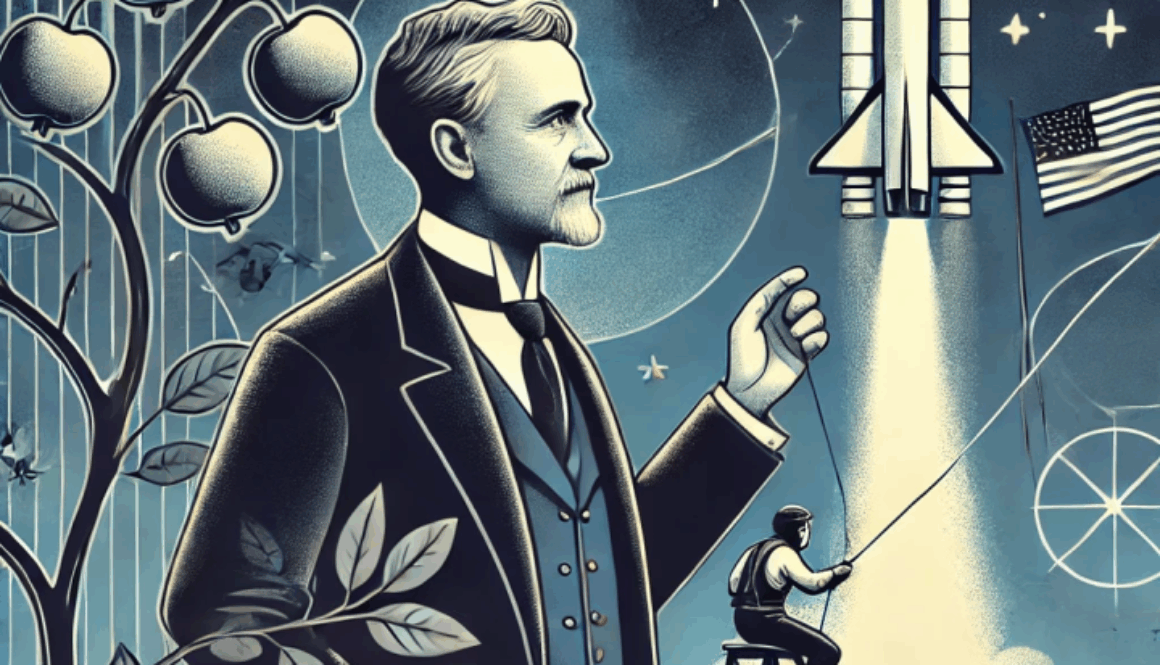
leadership


Corporate ADHD: Why Brands Can’t Focus (And Customers Can Tell)
Hey attention crash-testers—
Ever walked into a meeting with five priorities? Congratulations, you have zero.
Brands are burning out. Not because of lack of ambition — but because they can’t sit still. One quarter it’s Gen Z. The next it’s TikTok. Then it’s sustainability. Now it’s AI. And don’t forget NFTs, because someone’s cousin made a million with a pixelated llama.
We’re not iterating. We’re twitching.
And like a sleep-deprived intern juggling Slack, Zoom, and a boss yelling “BE MORE DISRUPTIVE,” brands are living through a full-blown attention crisis.
The result? Customers feel it. Employees drown in it. Strategy dies because of it.
The Corporate ADHD Epidemic
Let me tell you a story. A few years ago, I was consulting for a mid-sized fashion brand in Berlin. They called us in because “they wanted to rebrand.”
Classic.
But by week two, they weren’t sure if the priority was expanding their menswear line, launching a podcast, building a Roblox activation, or going full vegan.
I remember asking the CEO in a workshop, “What’s the one thing your customers come to you for?”
He paused. Looked around. Then said: “Aesthetics?”
It was a question.
This is how it always starts: with a loss of focus disguised as opportunity.
Their Instagram became a random mess of half-baked campaigns. They launched a capsule collection no one understood. Eventually, their loyal base started drifting. They weren’t angry — just… confused. Within 12 months, revenue was down 23%.
This is what happens when you confuse busyness with progress. When you chase everything, you dilute everything.

The Illusion of Agility
Corporate ADHD hides behind words like “agile” and “fast-moving.” But real agility isn’t about reacting to every trend. It’s about knowing when not to.
A 2023 Deloitte report found that only 17% of brands that adopted “rapid pivot” strategies post-Covid saw long-term growth. The rest either plateaued or regressed. Why? Because in most cases, the pivot wasn’t rooted in strategy — it was panic rebranded as responsiveness.
Take CNN+. Remember that streaming service? Neither does anyone else. It launched in 2022. Died in 2022.
Why? Because CNN tried to play Netflix without understanding their own audience’s media habits. They mistook the content boom for a license to diversify, instead of asking the obvious: Do people want more CNN… or better CNN?
Case Study: Oatly’s Focused Weirdness
Now, let’s flip it.
Oatly is weird. Purposefully so. You might think of them as just “the oat milk brand with the loud packaging.” But behind the chaos is ruthless focus.
Their tone is eccentric, but consistent. Their messaging — from TV spots to carton sides — always reinforces the same identity: irreverent, plant-based, anti-corporate.
In 2020, they had a 70% market share in Sweden’s alt-milk category. Globally? They became a symbol of how to be everywhere without being everything.
Even when expanding into Asia, they didn’t dilute. Same fonts. Same humor. Same activist edge. That coherence makes them recognizable — and trustworthy. You don’t need to love oat milk to know what Oatly stands for.
That’s strategic focus. Not rigidity. Not sameness. Focus with personality.

Saying No
In 2022, I was working with a startup in the food tech scene — a scrappy team of twelve, great product, good energy. They’d just closed a decent seed round and were drunk on potential. At our kickoff meeting, the founder burst in late, phone still glued to his ear, and launched into a monologue:
“We want to expand into Germany, open a pop-up in London, relaunch the website, hire a Head of Brand, start a podcast, and explore a metaverse experience — oh, and maybe do something with NFTs.”
I remember blinking, sipping my lukewarm espresso, and saying, “Pick one. Then we’ll talk.”
They weren’t thrilled. They paused the project. I think the CMO even rolled his eyes.
Three months later, I got an email. Subject line: “We should’ve listened.”
The campaigns had flopped. Social was a ghost town. Developers were building two unfinished landing pages at once. Everyone was exhausted. They’d burned through half the budget, chasing noise over clarity.
It was a classic case of cognitive overload disguised as ambition. And saying no wasn’t just advice — it was the only act of strategic mercy I could offer.
Focus isn’t sexy. But it’s the only thing that scales.

Symptoms of Corporate ADHD
- You’re launching five things and maintaining none
- Your team is burned out but directionless
- You’re on every social platform — but with no strategy
- Quarterly goals shift monthly
- No one can articulate your brand’s core narrative in one sentence
According to a 2024 PwC survey, 64% of marketing leaders say their biggest struggle is “too many simultaneous priorities.”
So How Do You Treat It?
Here’s the checklist. Stick it to your office wall:
- Define what you don’t do — Strategy is subtraction.
- Audit your narrative every quarter — Are you still telling the same story?
- Build fewer things, but finish them — Launch less. Land more.
- Reward long-term KPIs — Not just engagement spikes.
- Make ‘no’ a default option — Kill ideas fast. Before they become projects.
I’ll leave you with this.
A few years back, while consulting for a lifestyle brand drowning in half-launched projects, I remember sitting in a dim-lit boardroom covered with sticky notes. The walls screamed potential. But none of it stuck. Each note represented a “priority” — which, by definition, meant none really were. The founder looked at me, wide-eyed, and asked: “So… which one do you think we should go all in on?”
I replied: “Which one would still matter if TikTok disappeared tomorrow?”
Silence.
That’s what focus sounds like.
In a business culture that rewards noise, focus is an act of rebellion. It means resisting the dopamine hit of constant novelty. It means building something — slowly, consistently — until it matters. And it means having the courage to stay boring long enough for your audience to trust you.
Because customers don’t leave because you’re boring. They leave because you’ve lost the plot.
Until next time, stay grounded.
Alex
If your brand feels overwhelmed by too many ideas and zero clarity, we can help. At Kredo Marketing, we turn chaos into strategy — and ambition into results. Let’s talk before your audience drifts away.

Digital Darwinism: Why Most Brands Aren’t Evolving
Hey evolutionary misfits—
Some brands evolve. Most just mutate. And the difference between the two?
Survival.
In the natural world, evolution is adaptive. It’s a response to the environment. But mutation? It’s random. It’s the business equivalent of slapping a TikTok account on a B2B software firm because “everyone’s doing it.”
Welcome to the age of Digital Darwinism, where tech moves faster than strategy, and survival isn’t guaranteed by innovation — but by relevance.
The Law of the Jungle Is Now the Law of the Feed
Evolution doesn’t reward the strongest or smartest. It rewards the most adaptable. And in marketing, adaptability doesn’t mean chasing trends — it means responding to user behavior, technological shifts, and cultural context with intention.
Blockbuster. In 2000, they laughed Netflix out of the room. In 2010, they were bankrupt. Not because streaming killed them overnight — but because they failed to adapt while their customers did.
It’s never the comet. It’s always the inertia.
Mutation Marketing: A Dangerous Game of Brand Roulette
We see it every day: brands mimicking each other like confused parrots. Suddenly, everyone’s “disruptive,” using the same shade of blue, writing like Duolingo, and putting “AI” in places it has no reason to be.
That’s not evolution. That’s panic-induced mutation.
A McKinsey study in 2023 found that 61% of rebrands failed to improve customer perception.
Why? Because they weren’t strategic responses.
They were stylistic overhauls without ecosystem thinking. If you’re just re-skinning your brand without re-thinking your relevance, you’re not evolving.
You’re molting.

Kodak vs. Fujifilm
Let’s rewind to the early 2000s. Both Kodak and Fujifilm were dominant forces in the film photography world, staring down the barrel of digital disruption.
Kodak had the upper hand in brand recognition. They even invented the digital camera back in 1975 — and shelved it to protect their film business. Their corporate DNA was deeply tied to physical film, and their internal culture was allergic to cannibalizing it.
Fujifilm, on the other hand, saw the writing on the wall and treated digital not as a threat but as a signpost. They invested heavily in R&D and diversified, leveraging their core capabilities in chemicals and imaging into medical diagnostics, regenerative medicine, and cosmetics (see: their successful skincare line Astalift). By 2012, they had cut their film business down to just 1% of total revenue — and thrived.
Kodak filed for bankruptcy in 2012. Fujifilm grew.
It’s not that one had better tech. It’s that one had the cultural flexibility to adapt — and the strategic foresight to redefine itself.
Both giants. Both hit by the rise of digital photography. One died. The other pivoted.
Kodak clung to film like a security blanket. Fujifilm, meanwhile, leveraged their chemical expertise to branch into cosmetics, pharmaceuticals, and healthcare imaging. Today, Fujifilm is thriving.
Same threat. Different reaction. Different outcome.
Evolution is not about protecting the old. It’s about leveraging what’s core to adapt to what’s next.
Your Org Chart Is Fighting Evolution
It’s tempting to think evolution is a matter of tools. Better software, new platforms, smarter automation. But what if the real obstacle to evolution isn’t your stack — it’s your structure?
Most companies are built like machines: hierarchical, rigid, optimized for repeatability. But digital ecosystems are more like organisms — fluid, messy, adaptive. And when a machine meets an organism, guess who bends?
Legacy org charts are the biggest blockers to adaptive change. Why? Because they’re designed to preserve stability, not embrace flux. Consider how ideas travel inside a traditional company: a junior UX researcher has a brilliant insight from user testing. That insight needs buy-in from a PM, who needs approval from a director, who then waits on quarterly alignment from the brand VP. By the time it gets greenlit, the customer behavior has already changed.
According to a 2023 Capgemini report, companies with highly siloed structures were 42% less likely to complete digital transformation initiatives compared to those with cross-functional teams and flatter hierarchies.
Even when companies talk about agility, they often just repackage old structures with new terminology. “Squads” that still need director approval aren’t agile. They’re theatre.
And let’s not forget the human layer: job titles as identity, turf wars over brand ownership, resistance to anything that threatens legacy metrics. These aren’t just annoyances — they’re evolutionary handbrakes.
If your org chart rewards maintaining the status quo, you’re not set up to evolve.
You’re set up to ossify.

What Evolutionary Brands Actually Do
- They experiment with intent — Testing isn’t about novelty. It’s about feedback loops
- They hire anthropologists, not just analysts — Data shows you what. Anthropology shows you why.
- They invest in internal evolution — It’s not just the brand. It’s the mindset.
- They question legacy success — What worked five years ago might be the anchor today.
Look at Spotify: continuous redesigns, regional personalization, and AI-curated listening that adjusts to your mood.
That’s brand evolution in real-time.
Checklist: Are You Evolving or Just Twitching?
Think of this as your brand’s evolutionary stress test — a diagnostic to understand whether you’re adapting with purpose or just convulsing at every passing trend. Mutation is easy. Evolution is hard. Let’s find out where you stand.
- Do you have a test-and-learn loop integrated into marketing? Not just A/B testing banners, but systemic loops that influence product, communication, and UX? Brands like Booking.com run thousands of experiments weekly — what’s your volume?
- Are you tracking cultural shifts — not just industry trends? It’s easy to follow what competitors do. It’s harder (and more valuable) to decode cultural codes and shifts in user sentiment. Are you tuning into Reddit, TikTok, and Discord — or just reading LinkedIn posts?
- Is your design changing with user behavior or despite it? Figma’s rise wasn’t just because of design tools — it aligned with how distributed teams work. Is your design evolving from user input, or is it dictated by the latest Dribbble trends?
- Do your values evolve or just your color palette? Rebrands often change the visuals, but keep dated slogans and outdated tone. Patagonia evolved their messaging with climate urgency — have you evolved yours?
- Are your KPIs driving relevance or just performance? Are you tracking Net Promoter Score without understanding what drives it? Do you know why your bounce rate is high or just that it is?
The goal isn’t to tick boxes. It’s to trigger honest reflection. Because evolution requires discomfort. Mutation just needs panic.
and the winner is…
Brands don’t go extinct because the market changed.
They go extinct because they didn’t.
In the age of Digital Darwinism, clarity beats chaos, strategy beats novelty, and intentional evolution beats blind mutation.
Until next time, stay adaptive.
Alex
Want your brand to evolve, not just mutate?
Let’s work together to build strategies that survive the next wave.
👉 KREDO is Here!

Your Competitors Are Boring. Why Are You Copying Them?
Hey creative rebels —
Let’s start with a brutal truth: most of your competitors are boring.
Their campaigns blend into a sea of sameness. Their social posts are indistinguishable. Their websites? Templates with empty words and safe colors. And yet — so many brands still copy them.
Why?
Because in the absence of courage, familiarity feels safe. But safe rarely makes history. Safe is the enemy of distinctiveness. And distinctiveness is the only thing that makes marketing work.
The illusion of safety in sameness
A 2024 Deloitte study found that 74% of mid-sized companies admitted to modeling their marketing strategies on industry competitors rather than consumer insight or brand purpose.
It’s herd behavior dressed up as strategy.
The logic?
If they’re doing it, it must work. But if everyone copies, no one leads. And when no one leads, the entire category sinks into mediocrity.
Picture this: you’re on Instagram, scrolling through ten profiles of fashion brands. Neutral palettes. Soft lighting. “Authentic” lifestyle photography. Vague captions about community and sustainability.
You swipe, you forget.
A 2023 Nielsen survey confirmed it: 67% of consumers feel brand content today is interchangeable and forgettable. This isn’t branding.
It’s hiding in plain sight.
It’s tempting to blame marketers for this sameness. But the rot runs deeper. Copying is a symptom of how most organizations are structured. Boards reward the safe bet. Investors favor predictability over originality. Procurement departments prioritize cost savings over craft. Agencies pitch ideas they think will pass through layers of approval, not rock the boat. The machine is built to favor “good enough” over “truly bold.”
And so we copy.
Because standing out might mean standing alone at the next board meeting, defending the unfamiliar. That’s hard. It’s easier to point at a competitor and say: We’re doing what they’re doing.
How copying poisons categories
🔹 D2C mattress wars: Casper shook up an industry. But within two years, a flood of copycats diluted what made them special. 60% of post-2017 D2C mattress startups failed or sold at a loss (CB Insights, 2023). The category drowned in its own mimicry. CACs spiked. Margins shrank. Customers couldn’t tell one from another — so they stopped caring.
🔹 Fintech’s ocean of blue: Fintechs chose blue because blue “signals trust.” But when everyone chose blue, no one stood out. A McKinsey 2023 study found brand recall dropped 35% in fintech between 2019 and 2023. In focus groups, users couldn’t match logos to names. Trust became wallpaper.
🔹 Pepsi’s Kendall Jenner ad: An attempt at boldness that flopped — because it mimicked activism without meaning it.
Different isn’t enough. Different must be true.
What bold brands actually do differently
✅ They seek inspiration beyond their category. Oatly looked to punk zines. Liquid Death borrowed from metal culture. Aesop channels perfumery, not skincare.
✅ They design to be felt, not just seen. Mailchimp’s quirky illustrations and playful tone make SaaS human.
✅ They lead with messy, authentic purpose. Patagonia’s activism. Ben & Jerry’s loud social stands. They don’t follow the conversation. They start it.
And crucially — they accept that daring means sometimes failing. Because failure in the pursuit of originality is more valuable than success in the art of imitation.
How to break the copycat cycle: a framework
👉 Audit your brand like a stranger: Could your assets belong to a competitor? If yes, rebuild.
👉 Ask the tough questions: What truth do we stand for? Where do we blend in? Where could we be unforgettable?
👉 Prototype bravery: Test bold moves in small spaces. Not everything needs to go global on day one. But do something that makes you nervous.
Your competitors are boring. Let them stay that way.
You? You’ve got better things to do. The brands we remember tomorrow are the ones that dare today.
Until next time, stay bold.
Alex
At Kredo Marketing, we help businesses break the cycle of copy-paste strategies and build bold, memorable brands that stand out. Ready to stop blending in? Let’s connect.

Metrics as Myth: Why We Worship KPIs We Don’t Understand
Hey number chasers—
I once sat in a strategy meeting where a team leader proudly presented a dashboard glowing with green arrows.
CTR up 30%.
Engagement rate up 25%.
Bounce rate down.
The room buzzed with approval. But one quiet voice at the back asked: “What happened to revenue?”The answer? Flat.
Customer churn? Up 7%. Silence followed. The team had fallen in love with numbers that made them look good — while the business quietly eroded.
We weren’t reporting insights. We were performing a ritual.
The seduction of the green arrow
Marketing didn’t start with dashboards. It started with people — stories, trust, connection. Metrics were supposed to help us measure these things. Instead, they became our gods. We chant CTR, CPA, DAU, LTV as if they’re magic.
But few pause to ask: Do I really understand what’s behind this number? What it reflects? What it hides?
According to a 2023 Gartner report, 68% of CMOs admit they report metrics they don’t fully trust or understand. A 2022 Forrester study found 54% of marketing dashboards are stuffed with vanity metrics disconnected from business outcomes. We do it because it’s easy. Because it calms stakeholders. Because it tells a comforting story — even when it’s fiction.
And here’s the brutal truth: sometimes the best-performing campaigns are the ones you can’t measure. Because they change culture, not clicks.
The most valuable ideas often resist quantification — but we ignore them, because they don’t fit the slide deck.

When metrics become myths: the real cost of chasing ghosts
🔹 The Facebook video bubble (2015-2018): Seduced by video view counts (later revealed to be overstated by up to 80%), media companies laid off thousands after betting billions on a metric that was a mirage.
🔹 The NPS delusion: Airlines boasting high NPS while ranking bottom in J.D. Power satisfaction surveys. NPS can be gamed; loyalty can’t.
🔹 Startup vanity growth: App developers proudly report millions of downloads — but fewer than 10% of users return after the first use (App Annie, 2023).
🔹 iOS15 open rate illusion: Teams cheered stable open rates, unaware Apple’s privacy updates had broken the metric’s meaning.
🔹 The rebrand trap: A major CPG brand spent millions on a rebrand that spiked awareness metrics by 200% — but drove a 15% sales decline as loyal customers no longer recognized the product.
Dashboard dopamine and budget black holes
Dashboards reward us like slot machines.
Green arrows and rising lines give instant gratification. But impact takes deeper digging.
MIT Sloan (2022) found companies chasing vanity metrics were 2.3x more likely to miss revenue targets. A HubSpot report estimated that up to 27% of marketing spend in mid-sized firms is wasted on efforts optimized for the wrong KPIs.
How much time, energy, and money are we burning worshipping the wrong numbers? How many great ideas are left unexplored because they don’t fit on a dashboard?

What we should measure — but don’t
✅ Cohort retention: Who stays beyond the first impression?
✅ Net revenue retention: Are we growing value, not just headcount?
✅ Behavior change: Did we shift habits, not just clicks?
✅ Customer advocacy: Who champions us unprompted?
✅ True ROI: Does each marketing dollar create durable value?
Patagonia tracks product returns as a proxy for quality. Signal measures success by active, engaged users — not downloads. Basecamp focuses on customer longevity, not lead gen volume.
A provocation for your next meeting
Next time you see a dashboard, try this:
👉 Remove one vanity metric. Watch what happens to the discussion.
👉 Ask: What’s behind this number? What human behavior does it represent?
👉 Challenge a metric that looks “too good.” Dig for what it’s hiding.
Because the most dangerous metric is the one that rises while your business quietly dies.
Until next time, stay skeptical.
Alex
At Kredo Marketing, we help brands cut through vanity metrics and build strategies grounded in what truly drives impact. Want to focus on value, not noise? Let’s talk.

Nobody Reads Anymore (Especially Your Boss)
Hey radical readers—
You’ve probably seen it happen: a report is sent, beautifully designed, meticulously written — and promptly ignored. Slides are skimmed, memos glanced at, emails flagged but never reopened.
And somewhere in the corner office, a decision is made based on a gut feeling or a quick chat — not your 38-page strategy deck.
Let me tell you about Klaus— don’t google it; It’s not his real name 🙂 — a German director at a logistics company I once consulted for.
Klaus ran operations like a chessboard, thinking ten moves ahead. But when it came to internal communication, he had one rule: Keep it short. Nobody reads anything longer than a WhatsApp message.
At first, I thought he was being cynical. Then I watched him in action. He’d skim executive summaries with the speed of a TikTok scroll, ask for bottom-line implications in Slack, and make million-euro calls based on bullet points.
Klaus wasn’t lazy. He was busy.
And, as I soon realized, he was far from alone.
We’re drowning in content, not starving for it
According to McKinsey, the average manager spends nearly 28% of their time reading and responding to emails— that’s over 11 hours a week.
Add Slack, Teams, dashboards, newsletters, KPI summaries, and you’re talking about a cognitive flood.

Reading has become a form of luxury. Deep attention is now a scarce resource — and we’ve trained ourselves to survive without it.
Research from @Gloria Mark, professor of informatics at UC Irvine and author of Attention Span (2023), shows that office workers switch windows or applications every 47 seconds.
Her research, grounded in years of observation and digital behavior tracking, reveals just how fragmented our attention has become. Her work has been featured in The New York Times, HBR, and beyond — because it strikes a nerve:
we’re operating in perpetual interruption.
That means your lovingly crafted report is competing with calendar invites, push notifications, and someone asking “Got a sec?” from across the open space.
And in this context, long-form anything starts to feel like an act of aggression.
The fetish of brevity is not the same as clarity
Here’s the twist: while people want short content, they also want to understand complex ideas quickly. This is where things get tricky.
You cut. You condense. You simplify.
But in doing so, you might also lose the nuance, the friction, the insight that made the thing valuable in the first place.
The result? Executive summaries full of buzzwords, stripped of soul. LinkedIn carousels masquerading as strategy. Infographics that look good but say nothing.
Simplicity is powerful — but only when it reveals. Not when it hides.
As French philosopher Pascal once said (ironically, in a letter): “I would have written a shorter letter, but I didn’t have the time.”

Reading is not dead. But deep reading is rare.
A Nielsen Norman Group eye-tracking study — NN/g is a UX research firm founded by Jakob Nielsen and Don Norman, both legends in human-centered design — found that users typically read only about 20% of the words on a web page during an average visit. They use visual scanning patterns, jumping between bolded terms, subheadings, and bullets.
This behavior doesn’t mean people are stupid — it means they’re overwhelmed.
Which is why the real skill isn’t just writing shorter. It’s writing structurally.
Like this:
- Start with a hook.
- Deliver one insight per paragraph.
- Use white space like it matters (because it does).
- Layer depth without demanding attention.
You’re not writing for people who are disinterested. You’re writing for people who are overstimulated.

But here’s the real problem: your boss might not want to read.
Here’s a spicy stat: IBM once found that 90% of all data created by businesses is never analyzed or used.
Now, some of that is noise. But a lot of it is reports, feedback, documentation, research — in short, the stuff that should have made decisions smarter.
Why is it ignored?
Because reading slows things down. Because text invites debate. Because nuance complicates decisions.
Reading means having to consider alternatives, acknowledge uncertainty, and admit that maybe — just maybe — we don’t have it all figured out.
But fast decisions need simplicity. Which is why decks get skimmed and dashboards win.
So what can you do if you still believe in thinking?
You learn to speak insight in the language of urgency.
Here’s how:
- Package big ideas in small containers. Think tweets, not essays.
- Build layered content: TL;DR up top, insight in the middle, nuance at the bottom.
- Use visuals — but only when they carry meaning, not just decoration.
- Write for one reader, not a committee.
And most importantly: measure clarity, not just impact.
Because sometimes, your job is not to be read. It’s to be understood.
And if that means putting your ideas on a napkin or a WhatsApp message, so be it.
What’s your trick to get your message across in a world that doesn’t read?
Drop it below. Or better: send it in emoji.
Until next time, stay readable.
Alex
If you’re still writing 30-page reports in a world that wants 3-second decisions, you’re not failing — you’re speaking the wrong language.
At Kredo, we help you turn complex thinking into clear action.
👉 Let’s simplify things: https://kredo-marketing.com

Late Bloomers – The Power of Achieving Success Later in Life
Hey there, Business Hackers!
Welcome to another edition of Business Hacks & Theories!If you enjoyed our last issue, “Beauty. How Much Is It Really Worth?”(have a look if you missed it!) get ready because this time we’re diving into a fascinating exploration of the myth of early success and the power of achieving greatness later in life.
Ever felt like you’re behind because you haven’t struck gold by 30?
Well, buckle up and let’s uncover the real statistics, impactful stories, and the truth behind the so-called “late bloomers.”
Everywhere you look, it seems like young entrepreneurs are dominating the headlines.
Mark Zuckerberg, Evan Spiegel, and Brian Chesky are often touted as the poster children of early success. This creates a narrative that if you haven’t founded a unicorn by your mid-twenties, you’ve missed the boat. But is this pressure to achieve early really all it’s cracked up to be?
Let’s start with the hard truths.
Recent studies show that young adults today are facing unprecedented levels of stress, anxiety, and depression. The Behavioral Risk Factor Surveillance System (BRFSS) highlights that young adults are experiencing higher mental health issues compared to previous generations. A study published in the Journal of Abnormal Psychology found a significant increase in major depression and psychological distress among young adults from 2005 to 2017, largely due to the rise of social media and digital connectivity.
Social media creates a constant comparison trap.
People only show their highlight reels, making everyone else feel inadequate. The Royal Society for Public Health found that social media use is linked to increased rates of anxiety, depression, and poor sleep.
Society equates success with wealth and professional achievements.
This narrow definition neglects other fulfilling aspects like personal growth and relationships. Research from the American Psychological Association indicates that chasing extrinsic goals (like fame and wealth) leads to higher stress and lower life satisfaction compared to intrinsic goals (like personal development).

Early vs. Late Success
Let’s look at some examples:
Early Achievers like Mark Zuckerberg, who founded Facebook at 19, Evan Spiegel, who co-founded Snapchat at 22, and Brian Chesky, who co-founded Airbnb at 27, have certainly made headlines with their early success stories. They’ve created platforms that billions of people use every day, revolutionizing social media and hospitality.
But what about the Late Achievers?
Take Vera Wang, for instance. She launched her fashion career at 40 and built a globally recognized brand in bridal wear and beyond. Colonel Harland Sanders started KFC at 65, turning it into a global fast-food empire. Ray Kroc joined McDonald’s at 52 and transformed it into the world’s largest fast-food franchise. And let’s not forget Henry Ford, who established the Ford Motor Company at 40, pioneering the assembly line method and making cars accessible to the masses.
Older entrepreneurs often have a more substantial economic impact.
Here’s why:
Small businesses, many of which are founded by older entrepreneurs, are significant job creators. Over a span of 21 years from 1992 to 2013, these businesses accounted for 63.3% of net new jobs. This demonstrates how older entrepreneurs contribute significantly to the economy by generating employment opportunities.
Mature businesses, often started by seasoned entrepreneurs, tend to have higher initial revenues and exhibit greater long-term stability. These businesses benefit from the founders’ extensive experience and networks, which can lead to better decision-making and resilience in the face of challenges. As a result, businesses founded by older entrepreneurs often achieve more consistent and sustainable growth compared to those started by their younger counterparts.
By focusing on these aspects, we see that while young entrepreneurs bring fresh perspectives and innovation, older entrepreneurs leverage their experience and networks to create lasting economic impacts. This highlights the importance of valuing diverse entrepreneurial journeys and recognizing that significant success can come at any age.
Reality Check
The media’s focus on young entrepreneurs can create an “halo effect,” overrepresenting their successes compared to the actual data. The majority of successful entrepreneurs build their ventures over time, achieving significant milestones well into their 40s and beyond.
Success should not be measured solely by the speed or magnitude of achievements.
Here are ways to redefine success:
- Personal Growth and Well-being: Prioritize mental and physical health. Achievements are hollow if they come at the expense of well-being.
- Contributions to Society: Assess success by the positive impact one has on their community and the world.
- Embracing Failure: Normalize failure as a valuable part of the learning process.
- Respecting Time: Understand that everyone’s timeline is unique. Success does not have an expiration date.
While young entrepreneurs bring innovation and fresh perspectives, the statistical data underscores that significant entrepreneurial success often comes later in life. Recognizing and celebrating diverse entrepreneurial journeys, regardless of age, can foster a healthier and more inclusive view of what it means to be successful in business. The question should not be “How early did you succeed?” but rather “Are you happy and fulfilled with the path you are on?”
Stay savvy, and see you in the next issue!
Alex
Need help adapting your business strategy to the evolving market landscape?
Kredo Marketing is here to guide you through transformative strategies that future-proof your company.
Let’s collaborate and build something innovative together!
Don’t miss out on more content! Subscribe today to get exclusive insights straight to your inbox.
References and Further Reading
- Harvard Business Review: “The Age of Founders and Success in Startups” – This article discusses the average age of successful startup founders and challenges the myth of the young entrepreneur. Read more here.
- Behavioral Risk Factor Surveillance System (BRFSS): Provides data on the mental health trends of young adults compared to previous generations. BRFSS
- Journal of Abnormal Psychology: Study on the increase in major depression and psychological distress among young adults from 2005 to 2017. Read the study
- Royal Society for Public Health: Research on the impact of social media on anxiety, depression, and sleep.
- Business Insider: “25 People Who Became Highly Successful After Age 40” – Highlights stories of individuals who achieved success later in life.
- Stacker: “Entrepreneurs Who Built Companies After Age 40” – Discusses various entrepreneurs who found success later in life.
- StartupTalky: “Entrepreneurs Who Hit Big After Their 40s” – Details the stories of well-known late bloomers in the entrepreneurial world.

The Paradox of Corporate Jargon: How Complicated Language Became a Survival Tool
Hey semantic explorers—
I once sat in a meeting where a VP spent 14 minutes explaining that we were “initiating a synergy-driven ecosystemic transition toward scalable operational realignment.”
What he meant was: we’re changing the org chart.
Nobody laughed. A few nodded.
The more complex his words became, the more seriously he was taken. The fewer people understood, the more people agreed.
Welcome to the modern workplace, where using big words has become a survival strategy — and where clarity is not a virtue, but a liability.
Let’s be honest: nobody talks like that at dinner. You don’t tell your partner, “Tonight I’m initiating a caloric intake optimization protocol.” You say, “I’m ordering Thai.”
But in business? Abstraction is armor.
The use of inflated, intellectual-sounding words often signals not intelligence, but insecurity. When clarity might expose a flawed idea, vagueness keeps it afloat.
“People fear being simple because simple is naked. It forces a conversation about substance.”
And substance is risky.
There’s a kind of performative complexity that lets you sound impressive without being understood. And when nobody understands, nobody pushes back. That’s not just communication — that’s strategy.

The Language of Access and Power
The French sociologist Pierre Bourdieu called it linguistic capital. The more you master the “code” of a system, the more access you get.
In corporate culture, that code isn’t poetry — it’s phrases like “scalability roadmap,” “value chain optimization,” “cross-functional integration.”
What’s the difference between saying “Let’s make this simpler” and “Let’s optimize the interface touchpoints”? Nothing. Except the latter sounds like you went to business school. And that’s the point. Language becomes a proxy for competence.
“If I can’t decode you, you must be smarter than me.”
This is how mediocre thinkers rise: they master the code before mastering the craft.
Strategic Vagueness and the Safety of Smoke
The more ambiguous a plan, the harder it is to measure. And the harder it is to measure, the harder it is to criticize.
Take this real example from a Fortune 500 internal memo: “We will deploy a dynamic reframing of our customer-centric paradigm to enable agile ideation.”
What does that even mean? Literally nothing. But it gives the impression of movement while saying nothing specific — which is perfect, if you want to avoid accountability.
This isn’t rare.
Stanford’s behavioral linguistics lab found in a study that the more abstract the language in performance reviews, the less likely negative feedback was to be included. Simplicity, apparently, feels too sharp. Too confrontational.
It’s no surprise, then, that abstraction becomes a shield. The vaguer you are, the safer you stay.

Steve Jobs was known for ruthless simplicity — “Real artists ship,” “It just works,” “1,000 songs in your pocket.”
Yet for every Jobs, there are ten consultants billing €200/hour to design “cross-platform activation frameworks.”
Why? Because clarity is threatening. It eliminates excuses. It closes the door on bluff.
Remember the Theranos pitch decks? Beautifully written, slickly vague. Had they stated clearly what they couldn’t prove, they’d have never raised a cent.
Sometimes, obscurity isn’t just style — it’s survival.
If you’re one of those people who thinks words should meanthings, here’s the bad news:
the game is rigged.
But the good news? Clarity, when used well, can become your signature.
You don’t have to play dumb. You just have to talk real.
Things to try:
- Replace three buzzwords in your next presentation with real verbs. Watch the room.
- Ask your team what a term really means — then wait.
- Write your next strategy in one paragraph. No nouns longer than 10 letters.
Because in a field addicted to linguistic smoke, real words cut through like fire.
What’s the worst example of corporate nonsense-speak you’ve ever heard?
Drop it below. Let’s build the Museum of Jargon! 😉
Until next time, stay sharp.
Alex
At Kredo Marketing, we help brands simplify their message and amplify their difference. No Jargon. Just positioning that cuts through.

Mediocrity Is the New Currency of Corporate Success
Hey you clever rebels,
Let me tell you about a guy I’ll call Marco — not his real name, obviously. I’ve changed it to protect his privacy, though if you’ve ever worked in a large company, you’ve probably met a Marco or two.
We crossed paths years ago in a consultancy firm that lived and breathed spreadsheets. He was one of those rare voices in the room — a systems thinker, fast on his feet, allergic to clichés. The kind of guy who would raise his hand not to echo, but to question. Always respectful, but always sharp.
One day, after yet another internal strategy session — you know, the kind where the blandest roadmap gets hailed as ‘visionary alignment’ — Marco leaned in and muttered: “You know what this place rewards? Beige.”
Then he sat back and crossed his arms, half-smirking, half-exhausted.
It wasn’t the first time I’d heard something like that. But it was the first time it felt like a diagnosis, not a joke.
That phrase stuck with me. Because beige doesn’t scare anyone. Beige is safe. Beige is exactly what most companies want — even if they post on LinkedIn about disruption, courage, or innovation.
So here’s the uncomfortable thesis of today:
mediocrity isn’t accidental — it’s a strategic advantage in corporate systems that fear originality.
Let’s rip this apart.
Mediocrity Feels Safe (and Safety Sells)
Big organizations aren’t designed for brilliance. They’re designed for continuity.
They don’t want someone who questions the whole process. They want someone who can sit through 8 hours of meetings without raising a hand.
Why?
Because predictability scales. And exceptional minds? They tend to shake foundations.
Mediocrity becomes a performance. A carefully curated blend of consensus, jargon, and non-threatening ambition.
“Great idea, let’s circle back next quarter after we realign with our stakeholders.”
You want proof? Look at the case of Kodak. They literally invented digital photography. But the idea was buried internally for years — too radical, too risky, too disruptive to their existing business model. The engineers who pushed for it were sidelined. The company that played it safe went bankrupt.
Talent Is Often Seen as a Risk, Not a Resource
Ever noticed how the truly insightful person in a meeting is often ignored?
Not because they’re wrong. But because their insight doesn’t fit the pre-approved narrative. It’s easier to approve a “Best Practices 2.0” than someone suggesting a clean slate. Mediocrity doesn’t challenge status. It reinforces it.
Marco? He got sidelined for being “too intense.” Meanwhile, the guy who rephrased his points with more buzzwords got a promotion. I remember when Marco submitted a proposal to overhaul our entire client onboarding system. It was smart, cost-effective, and based on solid data. The response?
“Let’s wait until Q4.”
Two weeks later, his manager presented a watered-down version of the same thing. Guess who got recognition?
Another example: Elizabeth Holmes built an empire on vague promises and charismatic nothingness. Investors bought in not because the science was sound — but because the vision was comfortably packaged. Meanwhile, hundreds of medical innovators with real breakthroughs struggled for funding. Why? Because truth is messy, and mediocrity is easy to brand.
Vagueness Is the New Armor
Corporate-speak is a fortress. People hide behind phrases like “alignment”, “synergy”, and “value-driven execution” to avoid committing to anything measurable.
The more abstract your words, the harder it is to hold you accountable. And guess who masters this? The mediocre. They’re fluent in plausible deniability.
A study by Stanford’s Graduate School of Business found that leaders who use vague language are more likely to be perceived as competent, even if their actual performance lags behind.
Why? Because abstraction feels intellectual — even when it says nothing.
There’s a fast-track, and it doesn’t involve brilliance. It involves:
- Learning the language of vague ambition
- Avoiding clarity at all costs
- Echoing leadership just enough to seem aligned, never disruptive
This isn’t incompetence. It’s adaptive behavior. And it works.
We could name names. But you’ve seen it firsthand. The manager who says “we’re on a transformational journey” without being able to explain what’s actually transforming. The VP of Innovation who hasn’t launched a new idea in years.
And yet — they keep climbing.
So What Now?
If you’re allergic to mediocrity, you have two options:
- Blend and Climb: Learn the language, play the game, sell small parts of yourself until you forget where they went.
- Build and Resist: Create your own space — whether through content, consulting, side projects, or micro-communities — where clarity and originality are not liabilities.
I’m not saying one is better. I’m saying: know the rules of the board before you play.
And if you still think merit wins by default, remember this: in 2020, research by Gallup showed that only 21% of employees strongly agree that their performance is managed in a way that motivates them to do outstanding work.
Most are just trying to survive the system.
Things You Can Start Doing Today
- Write something that actually says something. No fluff. No SEO garbage. Just value.
- Ask the one question in a meeting that makes people uncomfortable — respectfully.
- Stop reposting safe content. Share something that shows you think.
- Talk to other people who feel the same. There are more of us than you think.
Have you ever watched someone rise, not because they were great, but because they were perfectly forgettable?
Let’s dissect the system — together.
Alex

Why I celebrate Failures: Robert H. Goddard’s Journey
Hey there, business enthusiasts! Welcome back to “Business Hacks & Theories”. Last time, we uncovered the inspiring journey of Momofuku Ando,—>(check this article here) the inventor of instant noodles. This week, we continue our series “Lessons from Failure” with the fascinating story of Robert H. Goddard, the father of modern rocketry.
Our society’s obsession with success often leads to unrealistic expectations and pressures to emulate others’ achievements. This phenomenon, known as social emulation, can cause significant personal and financial setbacks. Understanding and studying failures is crucial for a more realistic perspective and informed decision-making.
Robert H. Goddardwas born in Worcester, Massachusetts, in 1882. From a young age, he was fascinated by space travel, inspired by H.G. Wells’ “The War of the Worlds.” His dedication to pursuing space flight became fixed on October 19, 1899, when 17-year-old Goddard climbed a cherry tree to cut off dead limbs.
As he gazed at the sky, his imagination soared. He later wrote:
“On this day I climbed a tall cherry tree at the back of the barn … and as I looked toward the fields at the east, I imagined how wonderful it would be to make some device which had even the possibility of ascending to Mars, and how it would look on a small scale, if sent up from the meadow at my feet. I have several photographs of the tree, taken since, with the little ladder I made to climb it, leaning against it. It seemed to me then that a weight whirling around a horizontal shaft, moving more rapidly above than below, could furnish lift by virtue of the greater centrifugal force at the top of the path. I was a different boy when I descended the tree from when I ascended.
Existence at last seemed very purposive.”
Despite severe health issues that confined him to bed as a teenager, Goddard used this time to read extensively and develop his scientific ideas. In 1907, while still a student, he conducted his first rocket experiments, resulting in a notable mishap that nearly burned down a school building.

Undeterred, Goddard pursued his passion for rocketry with relentless focus. In 1914, he received patents for a multi-stage rocket and a liquid-fuel rocket. Despite initial failures and public mockery, he continued to refine his designs. His perseverance paid off in 1926 when he successfully launched the world’s first liquid-fueled rocket. This modest achievement laid the groundwork for modern rocketry and space exploration.
One of the most poignant stories about Goddard involves his 1926 rocket launch in a cabbage field in Auburn, Massachusetts. The rocket, which he named Nell, stood just over 10 feet tall and flew for a mere 2.5 seconds, reaching an altitude of 41 feet and landing 184 feet away. This modest flight was the first successful launch of a liquid-fueled rocket and marked the birth of modern rocketry. The local press, however, was not impressed, and Goddard faced ridicule from both the media and his peers.
During World War II, Goddard’s work on rocket-assisted takeoff technology significantly advanced military capabilities. Known for his humility, Goddard often funded his research personally and worked in seclusion to avoid public scrutiny. One memorable quote from Goddard encapsulates his optimism:
“It is difficult to say what is impossible, for the dream of yesterday is the hope of today and the reality of tomorrow.”
This quote reflects his enduring optimism and determination.
Goddard’s pioneering work inspired future generations of scientists and engineers, paving the way for the Apollo moon landings and beyond. His legacy is honored through institutions like NASA’s Goddard Space Flight Center, which continues to advance space exploration

Lessons from Goddard’s Failures
- Perseverance Against Odds: Goddard’s journey underscores the importance of persistence. Despite numerous setbacks, he never gave up, leading to revolutionary advancements in rocketry. His early experiments often ended in failure, but each attempt brought him closer to success.
- Innovation from Passion: Driven by his passion for space travel, Goddard’s relentless pursuit of his dreams led to groundbreaking innovations, despite widespread skepticism. His dedication to his vision highlights how deep passion can fuel innovation even when faced with considerable challenges.
- Learning from Failure: Goddard saw each failure as a learning opportunity, refining his methods and designs through constant experimentation. For instance, his initial attempts at launching rockets resulted in explosions and misfires, but he meticulously documented these failures to improve future designs.
- Impact Beyond Success: Goddard’s contributions laid the foundation for the space age, influencing generations of scientists and engineers. His work demonstrated how perseverance and innovation in the face of failure can lead to advancements that benefit all of humanity. The principles he developed are still used in modern rocketry.
In “Lessons from Failure”, I aim to highlight how failure is a crucial part of the journey to success. Each story delves into the struggles, resilience, and eventual triumphs of individuals who have turned failures into stepping stones.
Join me on this journey, and perhaps find the courage to face your own failures with renewed determination.
What if your next failure is the seed of your greatest success?
Thank you for joining me on this exploration of Robert H. Goddard’s inspiring journey.
Stay tuned for more insights and hacks to boost your business acumen in the next issue of “Business Hacks & Theories”!
With Love, Alex 🙂